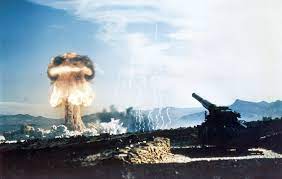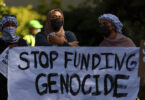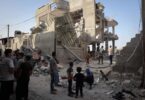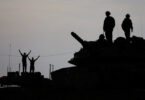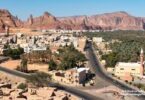Salwa Khokhar
Amidst the turbulent currents of history, there are moments when humanity stands on the percipe of profound transformation. In the realm of speculation, we embark on a journey that traverses the spectrum of possibilities from the pinnacle of advancement to the sobering descent into ashes. Our canvas is the aftermath of a conflict yet to occur: World War III.
As we explore the delicate interplay of hypothetical scenarios and modern nuclear realities, we cast our gaze upon a tapestry of what might be in a world where advancement and ashes entwine. Examining the escalating conflicts that are surfacing across the globe, it becomes apparent that the world is, once more, inching its way towards a precipice of a global conflict. Characterizing this impending conundrum as a “nuclear war” would indeed be an accurate assertion.
Amidst our trajectory towards the precipice of perilous conflict, particularly of the nuclear variety, it becomes paramount that we cultivate a lucid comprehension of the cataclysmic ramifications that such a war could potentially unleash. In the current global landscape, the presence of nuclear weapons has become a stark reality. Presently, there exist nine countries that hold these immensely destructive arms, introducing an intricate level of concern.
Of particular worry is the fact that these nations, each armed with the destructive power of nuclear weapons, have not historically maintained friendly relations with one another. If a third world war were to occur, it would mark the culmination of a final battle fought alongside human technology – an ultimate conflict that could once again thrust humanity into the depth of despair, the clash of nations armed with advanced technology could propel us into an era where the devastating impact goes beyond conventional warfare. The culmination of centuries of technological progress could ironically lead to a regression, plunging humanity back into a stone-age – like existence.
The advancements that were meant to elevate our society might instead become instruments of self-inflicted destruction, casting us into an era where the darkness of the past overshadows the potential of the future. Amidst these grave possibilities, the Doomsday Clock stands as a sobering reminder of the world’s vulnerability. Set by the Bulletin of the Atomic Scientists, the clock symbolizes the proximity to a global catastrophe.
Each tick of the clock echoes the urgency of addressing the perilous factors that threaten humanity’s existence, including the specter of nuclear conflict. In the face of such potential devastation, the clock’s hands inching towards midnight draw our attention to the unparalleled destructive power of nuclear weapons.
As our understanding of these weapons has evolved, we now possess the ability to calculate their potency with alarming precision. If a nuclear blast were to occur, the temperature at the location could rise to levels comparable to the surface temperature of the sun. The rapid expansion of a fireball quickly consuming vast distances within mere seconds underscores the instantaneous and catastrophic nature of a nuclear detonation. This knowledge goes beyond the immediate impact; the consequences of nuclear conflict can extend far and wide. Radioactive fallout follows the winds, potentially spreading through rivers that traverse multiple countries and threatening ocean life. In our interconnected world, these radioactive particles may infiltrate our food and water supply, highlighting the enduring global ramifications of such an event.
The chain of destruction will not end here; instead, in the days to come, the acts of devastation will likely increase further. According to well-known climatologist Professor Alan Robock, if a nuclear war were to begin, it is estimated that within a single day, a hundred and fifty million tons of smoke would disperse throughout the Earth’s atmosphere, resulting in a phenomenon known as “Nuclear Winter”. The condition of semidarkness, killing frosts, and subfreezing temperatures combined with high doses of radiation from nuclear fallout.
The extreme cold, high radioactive levels, and the widespread destruction of industrial, medical and transportation infrastructures along with food supplies and crops would trigger a massive death toll from starvation, exposure and disease. Scientists envision billions starving to death in a nuclear winter. Consequently, a nuclear war would spell the ultimate demise of humanity on Earth. Over the past sixty years, what has kept humanity from engaging in global conflict is cutting-edge nuclear technology.
However, it wouldn’t be incorrect to say that humans have, with their own hands, prepared the tools of their own destruction. Some might believe that nuclear warfare is undertaken to protect their own people, but in the process, the entire world could become entangled in the catastrophic aftermath of nuclear detonations, including them.
Nations possessing nuclear power should draw a lesson from the ‘Montreal Protocol.’ When scientists discovered a hole in the ozone layer caused by a gas called CFC, they realized its potential to completely destroy the ozone layer. In response, approximately 200 countries convened and collectively agreed to cease the production and use of such harmful CFCs.
Consequently, these substances are no longer in use, and the ozone layer issue was successfully resolved through global cooperation. The power of unity demonstrated by these countries in addressing environmental challenges showcases the potential for similar concerted efforts to prevent nuclear conflict and foster worldwide peace.

